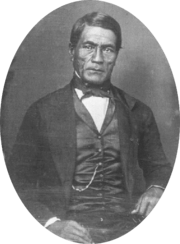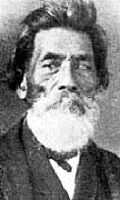John Papa Īī
| John Papa ʻĪʻī | |
|---|---|
 | |
| Born |
1800 Waipiʻo, Oʻahu |
| Died | May 2, 1870 |
| Nationality | Kingdom of Hawaii |
| Ethnicity | Native Hawaiian |
| Spouse(s) |
Sarai Hiwauli Maleka Kaapa Maraea Kamaunauikea Kapuahi |
| Children | Irene Kahalelauko-a-Kamāmalu ʻĪʻī Brown |
| Parent(s) | Kuaena and Wanaoa Kalaikane |
John or Keoni Papa ʻĪʻī or Keoni Papa Ii (1800–1870) was a 19th-century educator, politician and historian in the Kingdom of Hawaii.
Life
ʻĪʻī was born in 1800, the son of the Kona chief Kuaena and his wife Wanaoa Kalaikane[1] and raised under the traditional kapu system. His older brother was Daniel Papa ʻĪʻī. He was born at Waipiʻo, Ewa, Oʻahu.[2] His family belonged to the Luluka branch of the Luahine line, hereditary kahu to the chiefs of Hawaii.[1] ʻĪʻī was trained from childhood for a life of service to the high chiefs. At the age of ten he was taken to Honolulu by his uncle Papa, a kahu of Kamehameha I, to become a companion and personal attendant to Prince Liholiho, who became King Kamehameha II in 1819. ʻĪʻī was close to Liholiho during the young heir's instruction in the conduct of government and ancient religious rites. His master died in 1823 in England.[3]
After Liholiho's death, ʻĪʻī continued to serve the rulers of Hawai‘i and including being kahu for Victoria Kamāmalu and hānai father of Mary Polly Paʻaʻāina. ʻĪʻī was selected to be kahu of the students (effectively a vice principal) at the Chiefs' Children's School in 1840.[4] Throughout his life he was in constant contact with the political, religious, and social concerns of the court, as well as the common people.[5] ʻĪʻī was among the first Hawaiians to study reading and writing with the missionaries, yet although he adopted Christian teachings, he retained a profound love and respect for the culture of his ancestors.[3]

ʻĪʻī served as a general superintendent of Oʻahu schools and was an influential member in the court of Kamehameha III. In 1842, he was appointed by the king to the Treasury Board. He served as a member of the Privy Council 1845–1859 and in 1846 was appointed to the Board of Land Commissioners. ʻĪʻī served in the House of Nobles from 1841 to 1870. In 1852, he represented the House of Nobles in the drafting of the Constitution and became the Speaker of the House of Nobles. He served as a member of the House of Representatives during the session of 1855. He served from 1848 as a superior court judge, and from 1852 to 1864 as an associate justice of the Supreme Court of the Kingdom.[6] ʻĪʻī died on May 2, 1870.
Legacy
He left a first-hand account chronicle from 1866 until his death in a series of articles in the Hawaiian language newspaper Ka Nupepa Ku'oko'a.[5] These were translated by Mary Kawena Pukui and published in 1959 as "Fragments of Hawaiian History",[7] which describes life through his personal experiences under Kamehameha, and descriptions of the pattern of Hawaiian culture during a period of great significance in the history of the Hawaiian Kingdom.[3] A second edition was edited by Dorothy Barrère and published in 1983.[8]
His first marriage was to Sarai Hiwauli, the widow of Haʻalou, a chief executed for adultery. She died without issue in 1856, and he married nineteen-year-old Maleka Kaapa of Hilo in August 1, 1861, who died of consumption a month afterward. In 1862, he married for a third and final time to Maraea (Malaea) Kamaunauikea Kapuahi,[1] to whom was born his only child, Irene Kahalelauko-a-Kamāmalu ʻĪʻī. On September 30, 1886, Irene married Charles Augustus Brown and had sons George ʻĪʻī Brown on October 19, 1887, and Francis Hyde ʻĪʻī Brown on September 16, 1892; a daughter, Bernice, died young.[9] Irene divorced Brown in 1898 and married Carl Sheldon Holloway who died on July 26, 1915. The lands that John ʻĪʻī had been awarded were put into a trust called the John ʻĪʻī Estate, Limited, which was the subject of a lawsuit due to ambiguity in the original will.[10] Irene died August 22, 1922.
References
| Wikimedia Commons has media related to John Papa Īī. |
- ↑ 1.0 1.1 1.2 "II, John – LCA 8241 – Alii Award" (PDF). Kanaka Genealogy web site. Retrieved March 25, 2012.
- ↑ Title details ('John Papa Ii')
- ↑ 3.0 3.1 3.2 "Bishop Museum Press Authors". Bishop Museum. Retrieved 2009-10-27.
- ↑ Sheldon Dibble (1843). History of the Sandwich Islands. Lahainaluna: Press of the Mission Seminary. p. 291.
- ↑ 5.0 5.1 Michael Tsai (July 2, 2006). "John Papa 'I'i". Honolulu Advertiser. Retrieved 2009-10-27.
- ↑ "John Ii office record". state archives digital collections. state of Hawaii. Retrieved 2009-10-27.
- ↑ John Papa ʻĪʻī (1959). Fragments of Hawaiian history. Bishop Museum Press.
- ↑ John Papa ʻĪʻī (1983). Dorothy Barrère, ed. Fragments of Hawaiian history. Bishop Museum Press. ISBN 978-0-910240-31-4.
- ↑ John William Siddall (1917). Men of Hawaii: being a biographical reference library, complete and authentic, of the men of note and substantial achievement in the Hawaiian Islands. Honolulu Star-Bulletin. p. 50.
- ↑ United States Circuit Court of Appeals (1913). "John Ii Estate, Limited et al. v. Brown et al.". The Federal reporter: with key-number annotations 201. West Publishing Co. pp. 224–248.
|